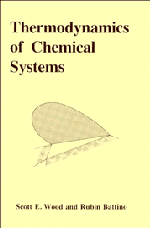Book contents
- Frontmatter
- Contents
- Preface
- Notation
- 1 Introduction
- 2 Temperature, heat, work, energy, and enthalpy
- 3 The second law of thermodynamics: the entropy function
- 4 Gibbs and Helmholtz energy functions and open systems
- 5 Conditions of equilibrium and stability: the phase rule
- 6 Partial molar quantities
- 7 Ideal gases and real gases
- 8 Liquids and solids: reference and standard states
- 9 Thermochemistry
- 10 Phase equilibrium
- 11 Chemical equilibrium
- 12 Equilibria in electrochemical systems
- 13 Surface effects
- 14 Equilibrium conditions in the presence of an external field
- 15 The third law of thermodynamics
- Appendices
- Cited references and selected bibliography
- Subject index
1 - Introduction
Published online by Cambridge University Press: 28 October 2009
- Frontmatter
- Contents
- Preface
- Notation
- 1 Introduction
- 2 Temperature, heat, work, energy, and enthalpy
- 3 The second law of thermodynamics: the entropy function
- 4 Gibbs and Helmholtz energy functions and open systems
- 5 Conditions of equilibrium and stability: the phase rule
- 6 Partial molar quantities
- 7 Ideal gases and real gases
- 8 Liquids and solids: reference and standard states
- 9 Thermochemistry
- 10 Phase equilibrium
- 11 Chemical equilibrium
- 12 Equilibria in electrochemical systems
- 13 Surface effects
- 14 Equilibrium conditions in the presence of an external field
- 15 The third law of thermodynamics
- Appendices
- Cited references and selected bibliography
- Subject index
Summary
With thermodynamics, one can calculate almost everything crudely; with kinetic theory, one can calculate fewer things, but more accurately; and with statistical mechanics, one can calculate almost nothing exactly.
Eugene WignerThe range and scope of thermodynamics is implied in Wigner's epigrammatic quote above, except for the fact that there are a great many phenomena for which thermodynamics can provide quite accurate calculations. Chemical engineering is to a large extent based on thermodynamic calculations applied to practical systems. The phase rule is indispensable to metallurgists, geologists, geochemists, crystallographers, mineralogists, and chemical engineers. Although students sometimes come away with the notion that thermodynamics is remote and abstract, it is actually the most practical of subjects. Part of what we endeavor to do in this book is to illustrate that practicality, the tie to everyday life and utility.
Thermodynamics comprises a field of knowledge that is fundamental and applicable to a vast area of human experience. It is a study of the interactions between two or more bodies, the interactions being described in terms of the basic concepts of heat and work. These concepts are deduced from experience, and it is this experience that leads to statements of the first and second laws of thermodynamics. The first law leads to the definition of the energy function, and the second law leads to the definition of the entropy function. With the experimental establishment of these laws, thermodynamics gives an elegant and exact method of studying and determining the properties of natural systems.
- Type
- Chapter
- Information
- Thermodynamics of Chemical Systems , pp. 1 - 5Publisher: Cambridge University PressPrint publication year: 1990



